by Sunny | Sep 28, 2018 | 01 What's New, Records & databases |
Obituaries and death indexes feature prominently in recently-updated collections at Ancestry.com. These collections take us around the world: from Australia to the U.S., Canada, England, Scotland, Ireland and Wales, then to Germany and The Netherlands.
Featured: Obituaries and death indexes
Genealogy giant subscription website Ancestry.com has updated 17 collections, several of which relate to obituaries and other death records. Many of these collections focus on recent deaths, which may not seem as valuable at first glance. But many obituaries contain genealogical clues back one or two or more generations, helping you link ancestors and descendants to each other in your family trees.
Furthermore, clues about a person’s death can lead you to all kinds of additional records: civil or church death records, tombstone inscriptions, cemetery and funeral records, wills and probate records, and even memorials in church or civic publications. So this is one must-have record type for every possible person on your tree for the past 100 years, or even more!
All the following collections come from Ancestry.com, where you can go to Search > Catalog to find the individual collections named below. (Just enter the collection title in part or full.)
Australia/New Zealand obituaries
“Australia and New Zealand, Obituary Index, 2004-2018,” now has more than 377,000 records. This is a fairly recent collection, but we also reported last month on updates to a sister collection of Australian newspaper vital notices dating back to the 1830s.
British Isles obituaries and deaths
An offsite collection that’s indexed on Ancestry, “Web: UK, Coal Mining Accidents and Deaths Index, 1878-1935,” now has nearly 103,000 records. According to the collection landing page, “This data is published by The Coalmining History Resource Centre. You can often find additional information by visiting the source website, including references, publication information, comments, historical context, and even images.”
The “England and Wales, Death Index, 2007-2017” at Ancestry.com now has more than 1.2 million records. The collection description says, “This collection is a compiled index that covers approximately 55% of the total deaths that occurred in this time period. This index provides death details for people in England and Wales, specifically their name, gender, date of birth or age at death, date of death, and residence place at death.”
“UK and Ireland, Obituary Index, 2004-2018” now claims more than 1.6 million records of recent deaths. “The collection contains obituaries from hundreds of newspapers. We work with partners to scour the Internet regularly to find new obituaries and extract the facts into our database. Where available we include the original URL link to the source information.”
The “Scotland and Northern Ireland, Death Index, 1989-2017” now includes over 525,000 records. It’s “a compiled index that covers approximately 45% of the total deaths that occurred in this time period. This index provides death details for people in Scotland and Northern Ireland, specifically their name, gender, date of birth or age at death, date of death, and residence place at time of death. However, they do not include the General Register Office (GRO) reference information. The index also contains a small number of records for people in Jersey and Isle of Man.”
Canada obituaries and notarial records
Ancestry’s collection of “Quebec, Canada, Notarial Records, 1637-1935” now tops 16.5 million records! According to the site, “Notarial records are private agreements (contracts), written by notaries, who are considered legal professionals. This collection consists of notarial records for Quebec from the years 1637 to 1935. Each notary set up practice and kept sets of records for documents they created.”
Looking for Canadian obituaries? The “Canada, Obituary Collection, 1898-2018” now has more than 1.4 million entries. Its historical depth—more than 100 years—and its inclusion of recent deaths set it apart from some other obituary indexes reported here.
Germany vital records
The collection “Mainz, Germany, Births, Marriages and Deaths, 1798-1875” now has nearly 900,000 records. The site offers excellent background for this database: “The current capital of the Rhine-Palatinate state in Germany, Mainz has a rich and storied history….Since the late 18th century, Mainz has been at times under French, Prussian, and German rule, and for a brief spell, it was a democratic free state.
“Initially, registrations of births, marriages, and deaths were kept by religious denominations, but with French occupation in the 1790s, a system of civil registration modeled on the French system was implemented in 1798. This collection includes civil registrations of births, marriages, and deaths beginning in 1798 and extending to 1875. In 1876, civil registration was implemented across unified Germany, and some of those records can be found in other Ancestry collections.”
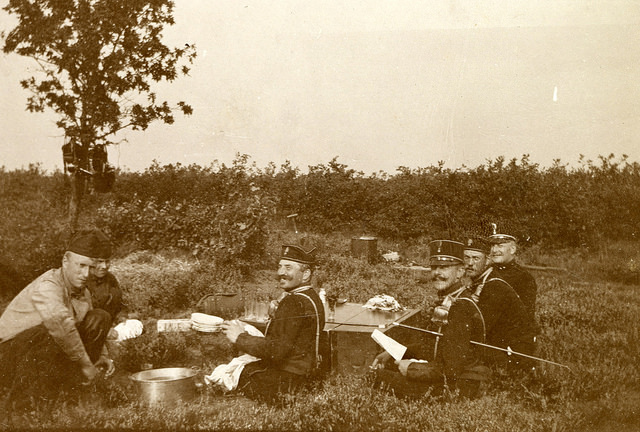
“Exercise Field Artillery Corps” album, image AKL092038, Netherlands Institute of Military History uploads at Flickr Creative Commons, https://www.flickr.com/photos/nimhimages/16026248719/.
The Netherlands: Obituaries and more
The Ancestry.com collection “Netherlands, Newspaper Announcements Index, 1795-1945” now has over 5 million records. “This collection consists of an index to announcements and advertisements from various newspapers. Approximately forty percent of the records are death (Overlijden) announcements. Just under one-quarter of the records are birth (Geboorte) announcements, and nearly as many are miscellaneous (Diversen) announcements or advertisements. The remaining records consist of marriage (Huwelijk) announcements. Details vary depending on the event….Also included is the name of the archive where the original record can be found, as well as a link to the record on the source website. In most cases, additional information about the original record will be available via that link. In some cases, images of the original records may be available via that link as well.”
United States obituary and death records
Two enormous collections of U.S. obituary and other death records have been updated at Ancestry.com. “U.S., Cemetery and Funeral Home Collection, 1847-2018” has passed 9 million records. The site describes the collection as one harvested from cemetery and funeral home records all over the Internet (to which individual entries link, wherever possible). A related collection, “U.S., Obituary Collection, 1930-2018,” now has nearly 40 million records, and is also described as a compilation of records gleaned from many resources online.
Got Oregon Trail ancestors? The “Willamette Valley, Oregon, Death Records, 1838-2006” collection now has more than 158,000 records. It “contains a collection of various death records for Willamette Valley, Oregon. Most are from Marion County. They include funeral home records, cemetery records, newspaper obituaries, and death certificates transcribed or compiled by members of the Willamette Valley Genealogical Society.”
Now topping 5 million records, the “New York, Death Index, 1852-1956” collection “consists of indices of deaths from the state of New York. Details vary, but may include the following information for the deceased: name, death date, death city, age at death, gender [and] certificate number.”
More to learn about obituaries
Not motivated enough yet to pursue obituaries for your relatives? Read our free article, 12 things you can learn in obituaries, and you’ll probably change your mind! An obituary isn’t just a record of a death: it’s often a window into a lifetime.
Disclosure: This article contains affiliate links and Genealogy Gems will be compensated if you make a purchase after clicking on these links (at no additional cost to you). Thank you for supporting Genealogy Gems!
by Lacey Cooke | Dec 8, 2017 | 01 What's New, Ancestry, Canadian, German, Records & databases
Big records updates at the Genealogy Giant website Ancestry.com! Brand new collections of birth, marriage, death, and census records for Canada were added this week, along with a Remembrance Book for the 100th anniversary of the Halifax explosion. Additionally, new vital records are now available for Germany.
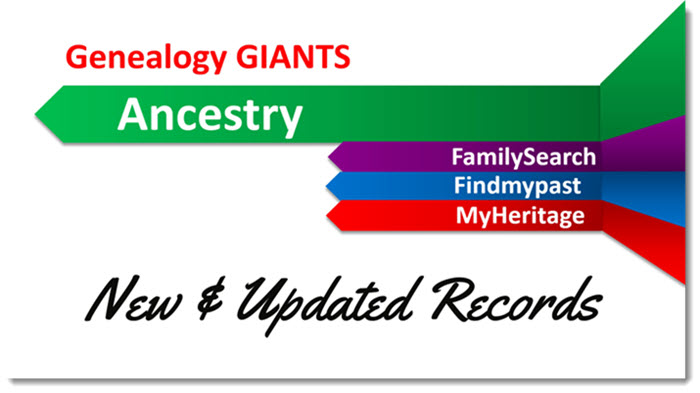
Canada – Birth, Marriage, Death, and Census Records
This year, December 6th marks the 100th anniversary of the Halifax explosion, which was a devastating maritime disaster in Nova Scotia, Canada. Ancestry has recently made available the ‘Halifax Explosion Remembrance Book,’ an online searchable database with detailed information for 1,946 casualties – more than 300 of whom are recently-confirmed and identified victims.
Ancestry also had a huge update of vital and census records this week for Canada:

AncestryDNA for Canada is on sale for just $99! Reg. $129 CAD. Sale ends 12/24/17. Excludes tax & shipping.
Alberta. Explore the new Births Index, 1870-1896, the Deaths Index, 1870-1966, and the Marriages Index, 1898-1942. Note that the marriage index is slightly irregular, in that each image only includes either the bride or the groom and their marriage year.
Newfoundland. Search baptisms and marriage records in the new collection of Church Records, 1793-1899. You’ll also find records from various churches in Newfoundland in the Births, Marriages, and Deaths, 1757-1901 collection, and the Births, Marriages, and Deaths, 1850-1949 collection. Also available are the 1921 Census, the 1935 Census, and the 1945 Census. Those databases originate from the Newfoundland Department of Tourism, Culture, and Recreation.
New Brunswick. New vital records collections start with Births and Late Registrations, 1810-1906. Then you’ll find Marriages, 1789-1950, which include registers, certificates, delayed registrations, and returns. And Deaths, 1888-1938 is also now online.
Prince Edward Island. Baptisms, Marriages, Burials, 1780-1983 is comprised of church records for Prince Edward Island. The Marriage Registers, 1832-1888 collection was created from newspapers, church records, and other sources that may or may not be provided. The Death Card Index, 1810-1913 contains pictures of the index cards from the Prince Edward Island Provincial Archives.
Nova Scotia. Lastly, Antigonish Catholic Baptisms, Marriages, and Burials, 1823-1905 are now available for Nova Scotia. The earlier registers are written in paragraph format, while later registers are typically pre-printed forms with information filled in by hand.
German Vital Records
Lots of new vital records collections for Germany recently became available, starting with Waldshut-Tiengen, Births, Marriages, and Deaths, 1870-1945. This collection of civil registers includes records from 9 additional communities which are today boroughs of Waldhut-Tiengen.
Next are Erfurt, Germany, Births, 1874-1901 and Marriages, 1874-1900. Additional events from the life of the child or the couple were sometimes recorded later on in the margins, but have not been indexed.
You’ll also find Zschopau, Germany, Births, 1876-1914, Marriages, 1876-1920, and Deaths, 1876-1958 now at Ancestry. It may be helpful to note that during the time period of these collections until 1918, Zschopau belonged to the Kingdom of Saxony.
Finally, Traunstein, Germany, Births, 1876-1905, Marriages, 1876-1934, and Deaths, 1876-1978 are also online, where you’ll find names, dates of birth, dates of deaths, witnesses, informants, parents, signatures, and other information.
Get the most out of Ancestry!
 Getting started on Ancestry.com can be a little daunting. As one of the world’s top genealogy websites, it’s packed with information about millions of people–perhaps including your ancestors. These step-by-step instructions will help you start building your family tree and learning more about your heritage. Click to read our recent article Getting Started on Ancestry.com.
Getting started on Ancestry.com can be a little daunting. As one of the world’s top genealogy websites, it’s packed with information about millions of people–perhaps including your ancestors. These step-by-step instructions will help you start building your family tree and learning more about your heritage. Click to read our recent article Getting Started on Ancestry.com.
Disclosure: This article contains affiliate links and Genealogy Gems will be compensated if you make a purchase after clicking on these links (at no additional cost to you). Thank you for supporting Genealogy Gems!
by | Jul 2, 2016 | 01 What's New, Cemeteries, Listeners & Readers |
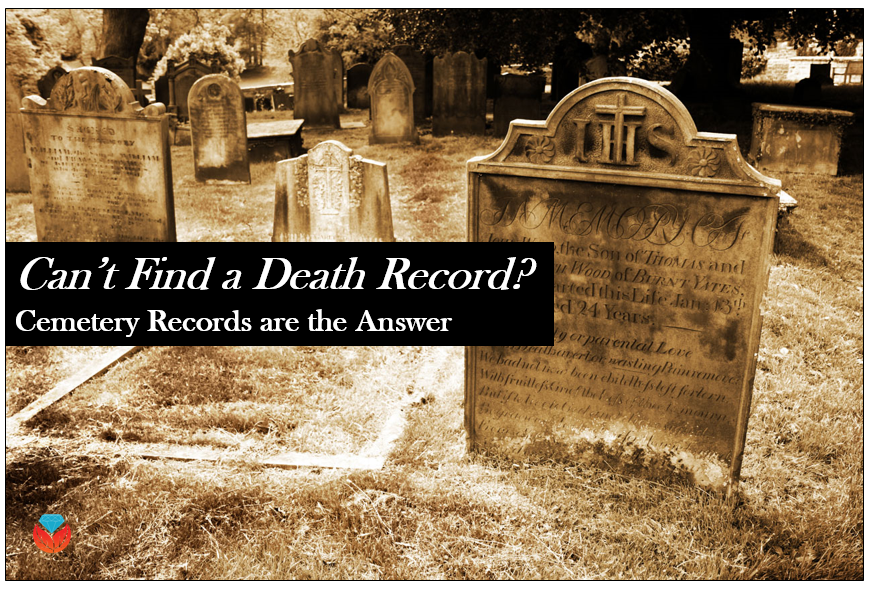 Cemetery records are a great alternative when you can’t find a death record. Here’s how to find them!
Cemetery records are a great alternative when you can’t find a death record. Here’s how to find them!
Genealogists are always on the hunt for records about the deaths of their ancestors. Death records sometimes offer a cause of death, birth information, and parents’ names. However, when a death record cannot be found, was never created, or was lost in a disaster, where should we look next? The cemetery, of course!
Genealogy Gems reader Brenda wrote us the following message:
My father and I were visiting the cemeteries in Preble County, Ohio. We decided to take a drive down Lock Road, which is named for my ancestors. We visited the home of my two times great-grandparents, Michael and Eliza Ann Lock. While visiting with the new home owner, they mentioned the tombstone located in the fence row behind the barn. The tombstone said “Eliza wife of Michael Lock.” The tombstone is hard to read, but I was also able to make out a “13” engraved on it and I know she died August 13, 1884. My problem is that there is also a tombstone listing her with her husband who died November 21, 1928 and a separate marker that says “Mother” marking a plot in Roselawn Cemetery in Lewisburg, Ohio. Would they have moved her body when her husband died or is she still buried on the homestead? I found records at the Preble County Library that references Eliza Lock and the cemetery plot in the Roselawn Cemetery. How do I know where she is actually buried?
Just short of ground penetrating radar and exhuming the body, we may never know for sure where someone is buried. There are some things we can do, however, to get the best answer possible and maybe find some new clues in the process.
Burial Locations of the Past
According to Ohio laws in 1884, burial regulations were made on the township or village level.[1] Further, it was permissible to bury a body within 200 yards of a dwelling if the home owner gave permission.[2] [Research tip: To search the law books of a targeted area, search Google Books with a keyword phrase like Ohio laws 1884.]
It was not uncommon to bury a person on the family farm in the old days. Many people had their own family cemeteries on their property. In fact, some states still allow private burials even today. In Ohio, a person seeking to have a private burial on their property should contact the county clerk. Read more about the current Ohio burial laws here.
Possible Theories
Theory #1: Eliza was buried at the farm and a marker was placed on her grave. Her husband died in 1928 and was buried in Roselawn Cemetery. The family decided to place a marker that had both of their names on it, even though Eliza’s body was left at the farm.
Theory #2: Eliza was buried at the farm and a marker was placed on her grave. Her husband died in 1928 and was buried in Roselawn Cemetery. The family moved Eliza’s body to the same plot in Roselawn and had a stone made for both of them.
Theory #3: Eliza was buried at Roselawn Cemetery and a small stone was placed to mark the grave. Then, forty-four years later when Michael died, the family removed the original stone and replaced it with a new one which was inscribed with both of their names. What did the family do with the old marker for Eliza? They took it home to the farm as a memento.
Using Cemetery Records to Confirm A Theory
We can check the burial or cemetery records for Roselawn Cemetery to determine who is buried in the plot of Michael Lock, who purchased the plot, and maybe some more helpful hints.
Cemetery records can usually be found in a cemetery office, a library, online, or in many cases, the offices or home of the township trustees.
First, Google the cemetery name and get a phone number. When calling the cemetery office, be ready with the name of the individual and the death date if known. If a record is found, ask for a copy to be sent to you and be sure to offer to pay the cost of mailing it to you.
If you are unable to reach anyone in the cemetery office, try a quick online search. Many local county organizations are digitizing and indexing these records to put online. I searched for “Preble County Ohio genealogy,” and found a website dedicated to historical and genealogical records for Preble county.
A quick search for Eliza Lock provided a hit!
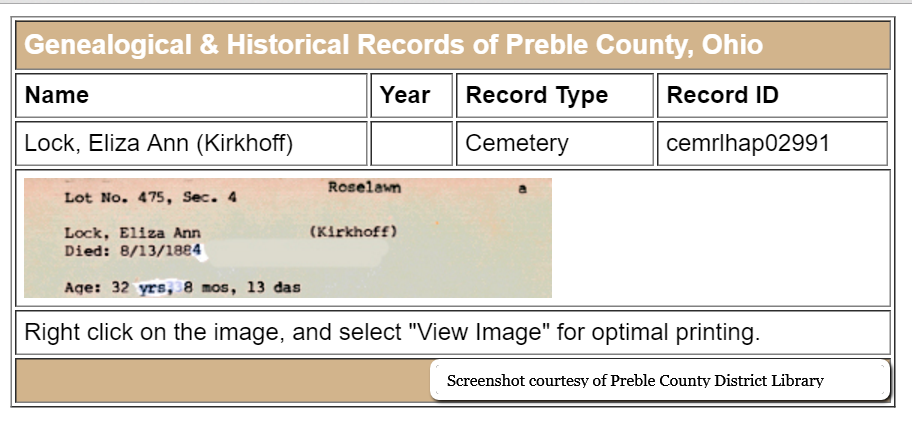
I noticed that there was a plot location and a death date, but not a burial date like I had seen on Michael’s index card. Michael’s card had two dates.
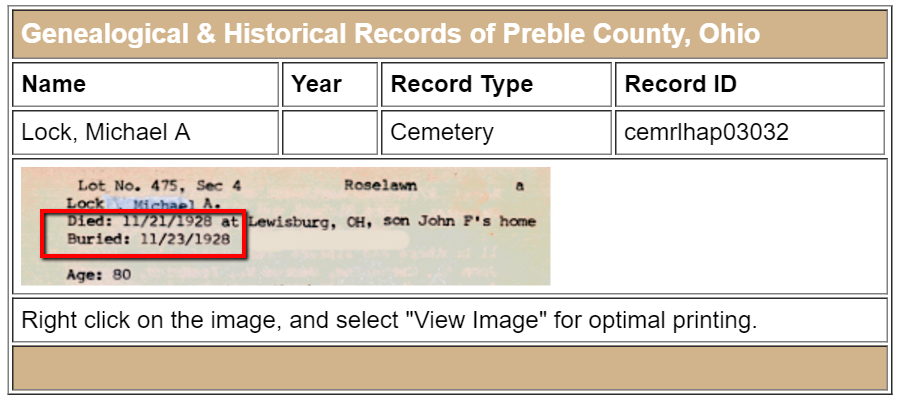
I checked many other cemetery records in this database. Several records created around the same time as Eliza’s death in 1884 also had no burial date. At first, I wondered if a record not having a burial date meant that the body wasn’t actually buried there. However, there were far too many records that did not include a burial date for this to be true.
I also noticed that this index card was a digital image and I wondered if it was created from some other source. It even seemed to have been altered with white-out. As with all genealogy research, if there is an original source, it should be found. In this case, I want to find out where these index cards came from. Were they created by someone who was looking at a ledger book? If so, then I want to see or view an image from the ledger book.
Locating the Original Cemetery Record Source
Sources come in two varieties – an original source and a derivative source. An original source is the one created at the time of the event. A derivative source is a record created later from the original, such as a transcription or abstraction. When a derivative is made, there is room for errors. This is one reason it is important to find the original source if at all possible. When it is not possible, you can use the derivative source as your proof, but you would indicate that it was a derivative and not an original.
Since this index was found at the library website, I gave them a call first. The Preble County Room assistant told me that the images were taken directly from the files held at the cemetery (the original source). The cemetery kept little index cards as their records. Volunteers later digitized those cards and uploaded them to the website (copy of an original source). According to the person I spoke to, there is no other ledger or record book that they know of. She did tell me that the image on the internet is only the top half of the digitized record (an abstract). This is yet another reason to discover how a record was made. If I had assumed this was the original record in its entirety, I would have missed some important clues.
She happily emailed me the full image of the index card (said to be a digital image of the original index card) and look what we see! [See image below]
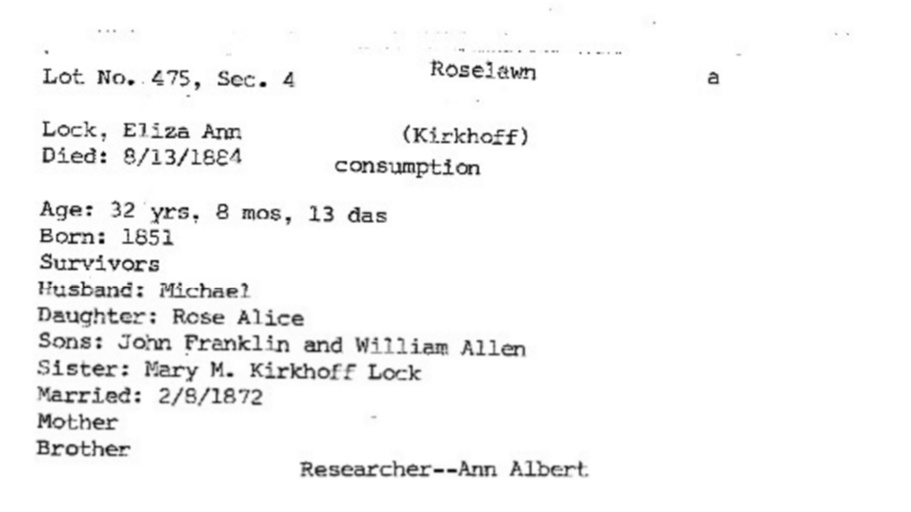
The full record held a lot more information. When I compared the lot number of Michael and Eliza, they were the same. According to this cemetery record, it seems that Eliza’s body is buried in the same plot as her husband at the cemetery. I speculate that when Michael died, the family decided to remove the original tombstone marking Eliza’s grave, put up a new one in its stead, and take the old tombstone back home instead of discarding it.
Cemetery records are a great asset to any family history research and can often hold new information. Start today and see what you can find!
Research Tip: Did you know that in many small Ohio townships, the cemetery record books may be at the home or office of a local township trustee? The cemeteries sometimes fall under the township responsibilities, instead of county or village. In my own township, the original cemetery books were once held by the local funeral director. Now, they are held by a township trustee who is in charge of the cemeteries. You can find the names of township trustees by performing a Google search like Harrison Township Preble County Ohio township trustees.
More Gems on Cemeteries and Cemetery Records
Premium Episode 69 – Cemetery Records with Deceased Online
Merry Cemetery Displays ‘Dirty Little Secrets’ of the Dead
Reviving a Memorial Day Tradition: Paper Flowers
ARTICLE REFERENCES
[1] The Revised Laws of Ohio: Containing All the Sections of the Statutes in Annual Volumes of Ohio Laws from Seventy-seven to Eighty-one, Inclusive, Arranged on the Plan of the Revised Statutes, 1884, Google Books, (https://books.google.com/books?id=QwZIAQAAMAAJ&printsec=frontcover#v=onepage&q&f=false : accessed 20 Jun 2016,) page 87.
[2] Ibid., page 195.
by Lisa Cooke | Jun 10, 2016 | 01 What's New, Records & databases

Here’s this week’s roundup of new genealogy records online: California, England, Australia, and Italy.
UNITED STATES – CALIFORNIA. Ancestry.com has added a new index titled California, Chinese Arrival Case Files Index, 1884-1940. This index includes passenger and crew lists of ships and airplanes arriving in California. Information you may find in these records are: name of passenger, ship name, port of arrival and in some cases, age, gender, birth date, birth place, and port of departure.
UNITED STATES – MILITARY. United States WWII Prisoner of War records for 1942-1947 have just been added to TheGenealogist.com in time for the anniversary of D-Day. These records inlcude U.S. military and Allies who were prisoners of war and internees. Some prisoners of both Germany and Japan are found in this collection. Records include the prisoners name, status, rank, service number, POW camp, and more valuable data.
ENGLAND – DEVON – PRISON RECORDS. Plymouth Prison Records for 1832-1919 at Findmypast include male and female prisoner records and prison officer records for Plymouth Prison in Devon. Recorded information includes name, birth date, offense, sentencing, last residence, residence of relative, physical description, and much more valuable data.
AUSTRALIA – QUEENSLAND – DEATH RECORDS. Findmypast subscribers can now conveniently search Queensland, Australia Death Records for 1829-1964 on Findmypast. These indexed records include: name, registration year, death date, father’s first and last name, mother’s first name, and sometimes her maiden name. (Birth, marriage and death indexes for Queensland are online for free at the State Library of Queensland website. Their death index goes from 1829-1986.)
ITALY – ROMA – CIVIL REGISTRATION. The Italian Civil Registration between the years of 1863-1930 has been newly added to FamilySearch.org. It is not yet indexed, but able to be browsed. Don’t be intimidated by its more than 4 million digitized images! They have broken down the database to be easily browsed by location and year. Marriage banns and residency records are just a two of things covered in this database.
 Don’t miss our newest free Genealogy Gems Podcast #192 for more tips and strategies to help you in your genealogy journey. Pop on over and listen now – we’d love to have you!
Don’t miss our newest free Genealogy Gems Podcast #192 for more tips and strategies to help you in your genealogy journey. Pop on over and listen now – we’d love to have you!
by | Feb 7, 2014 | 01 What's New, Collaborate, Source Citation
 I’m hearing so much these days about source citation and I love it! Everyone seems to be getting smarter and better at sourcing their research finds. And genealogy websites are making it easier and more collaborative. Here’s just one example, an announcement just made by BillionGraves:
I’m hearing so much these days about source citation and I love it! Everyone seems to be getting smarter and better at sourcing their research finds. And genealogy websites are making it easier and more collaborative. Here’s just one example, an announcement just made by BillionGraves:
“After months of work in response to hundreds of user requests, BillionGraves has added several new features designed to validate and enhance the headstone records found on BillionGraves. The Supporting Record feature now allows users to upload evidence-based documents that support the BillionGraves records that have been collected through our mobile Apps. This means that users are now able to upload headstones, birth/death, burial, marriage, cremation, and many other types of records without needing a smart phone.
Thousands of records are being uploaded every day and are breaking down genealogy brick walls and making connections that once seemed impossible. While working closely with our users and genealogists we found that there were many headstones and burials that just couldn’t be accounted for with our current systems; including unmarked graves, cremation scatterings, destroyed stones, and so on. Our Supporting Records features eliminate this problem while maintaining the validity and accuracy of the BillionGraves database.”



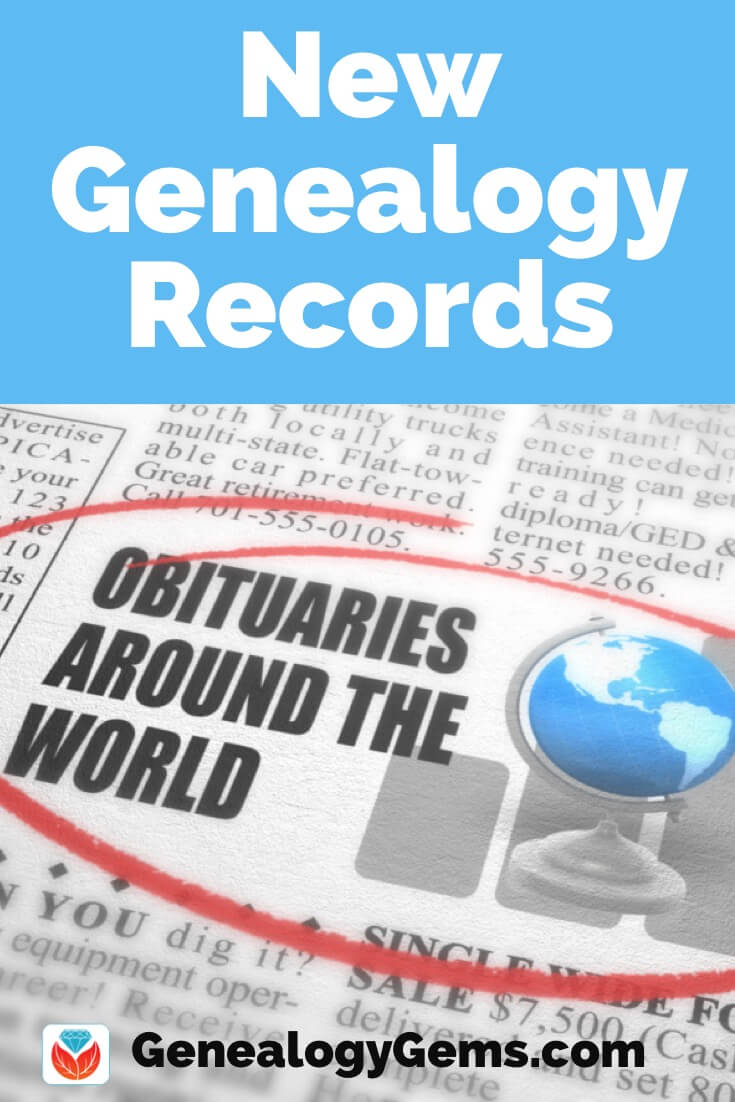
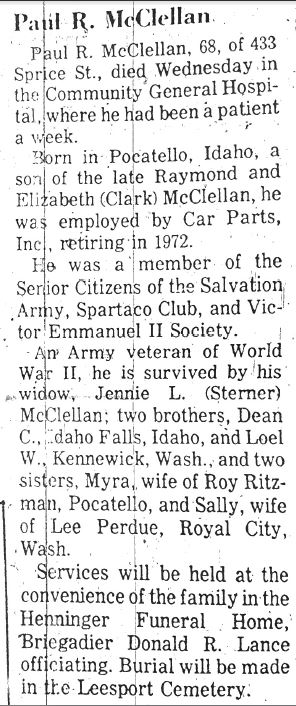
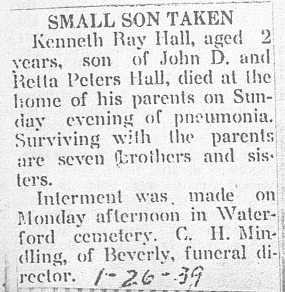


 Getting started on Ancestry.com can be a little daunting. As one of the world’s top genealogy websites, it’s packed with information about millions of people–perhaps including your ancestors. These step-by-step instructions will help you start building your family tree and learning more about your heritage. Click to read our recent article
Getting started on Ancestry.com can be a little daunting. As one of the world’s top genealogy websites, it’s packed with information about millions of people–perhaps including your ancestors. These step-by-step instructions will help you start building your family tree and learning more about your heritage. Click to read our recent article  Cemetery records are a great alternative when you can’t find a death record. Here’s how to find them!
Cemetery records are a great alternative when you can’t find a death record. Here’s how to find them!







